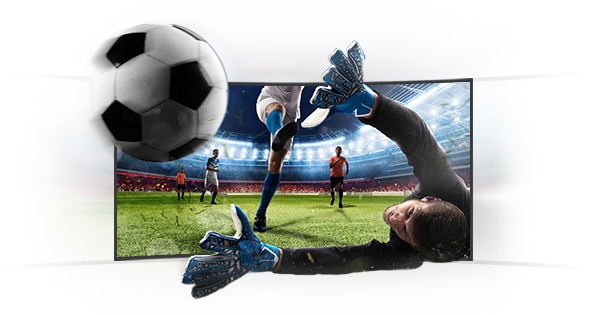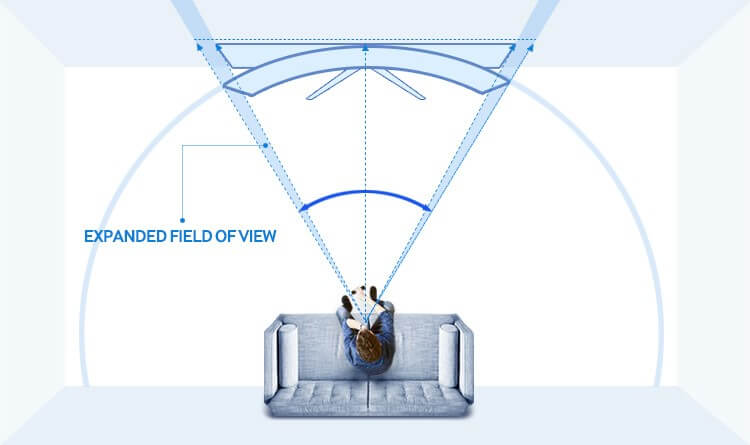
Curved screen and large screen monitors are ideal for busy workspaces. However, many workplaces have a problem when it comes to workstations: Their need for larger monitors to run large amounts of software and web applications conflicts with the shrinking space available for workstations. Read on for more details on how a curved monitor may help you get a better visual experience and discover solutions to maximize desk space with these monitors. Skip to the end of this blog for some insightful Q&A on how to mount Curved or Large Screen monitors in your environment or CLICK HERE for some recommended mounting solutions.
Exploring the Benefits of Curved Monitors
Curved monitors are fairly new technology, but they are quickly gaining popularity over flat monitors among astute users. There are numerous benefits to curved monitors due to their particular design, including reduced eyes strain and better field of view. Let’s jump into some other perks of a curved monitor.
First and foremost curved monitors give its users a more immersive experience. When it comes to entertainment, immersion is what most consumers want. To create this sense of immersion, products must be engineered in a way that replicates real life. The monitor technology specifically used in this case is called ocular perception. People see the world in three dimensions – length, width, and height. Curved monitors are able to take advantage of all three dimensions and expand on peripheral vision. This full immersion helps the viewer to forget they are staring at a screen and creates a much more enjoyable experience for the consumer.

Another benefit to curved monitors is that they eliminate distortion. Many times images and videos become blurry or distorted when enlarged, especially at the edges. Distortion issues are greatly minimized on curved monitors. The reason for this is explained by the physics of light projection. Flat screens blast their images in a straight line while curved screens take advantage of their shape, and aim everything at the viewer, which limits distortion.

Curved monitors are also more comfortable for our eyes. The light projection physics, as mentioned above, in curved monitors also improves the comfort of our eyes. This is because our eyes do not have to strain to see everything, all of the light created from the screen is directed to us, the viewer. Also, the curvature of the monitor allows our eyes to take in everything at once, without strain. The ability to take in a scene without strain is something that occurs naturally in everyday life. By being able to take in the entirety of a curved screen, even at its largest sizes, your eyes will take advantage of that natural feeling to remain comfortable.
Additionally, curved monitors offer a larger perceived field of view. This is true for the same reasons that curved screens are also more comfortable on the eyes. Since a curved screen directs light from all angles towards the viewer’s eye, the consumer will be able to take everything in without much eye strain.

In a business setting, curved screens have been beneficial in creating enhanced productivity. By reducing eye fatigue and discomfort, curved screens maximize the amount of time staff can work to their full potential. They also help employees to look at multiple things at the same time. Ultrawide curved monitors help desk workers to see (and work on) multiple open applications and windows simultaneously without disruption. There are various scenarios when this benefit could be helpful. For example, it can allow someone to see a spreadsheet of data while they write out their summary of its findings. Or it can help somebody monitor a live feed or messages, while still focused on their main task. It’s also particularly useful for creative roles as it improves color uniformity and creates further efficiencies by removing the time an employee may spend ensuring dual monitors are matched.

Stacked Screens: The Solution for Large Monitors in Shrinking Workspaces
As mentioned above many workplaces have a problem when it comes to workstations: Their need for larger monitors to run large amounts of software and web applications conflicts with the shrinking space available for workstations. Although desk space is shrinking and the ability to put two or three displays side by side isn’t possible there is almost always ample room to go up. There are several ways to make this happen but ideally, and what we will focus on, is dual monitor mounts (off one pole) that allow the upper screen to be pivoted and angled downward for easy viewing. These mounting systems typically have the added benefits of built-in cable management, fine-tuned adjustments and the ability, with some designs, to swing one or both screens away.
Research has confirmed suspicions that dual monitors increase productivity, as users spend less time opening and minimizing tabs and windows. The larger the screens, the greater the benefits. Jon Peddie Research, of the graphics and multimedia industry, found that dual monitors can boost office productivity by as much as 42 percent. Their research also found that multimonitor setups are no longer the exception; they’re the norm in many workplaces.
For Example, in a business setting, curved and large flat screens have been beneficial in creating enhanced productivity.In fact, many professions require that much screen real estate. In the world of finance, multiple screens have long been common at trading desks. Production facilities use multiple screens to provide dashboards for views on the status of operating equipment and mission-critical key performance indicators (KPIs). Security stations are using several screens due to lowered hardware costs and ubiquitous connectivity for more cameras and views in both business spaces and public settings. Health Care Practitioners need to see everything from patient records to reference information on drugs and diseases, as well as medical imaging. Building everything from computer games to action movies to advertising spots requires wide screens for producing and sequencing creative assets, and second screens allow for easier preview and quality control for creative production.
With curved monitors quickly becoming the new flat and both curved and large monitors increasing productivity in the workplace the ability to mount these monitors has been problematic. Thankfully technology has started to catch up and we have the mounts to support these monitors in all types of settings! It takes a special type of mount to properly fit these screens into an environment and many of our customers have had great questions for our mount experts on achieving the perfect mounting solution.
You Asked We Answered!
What follows are some helpful Q&A for those looking to upgrade their home or business with these Large or Curved screens:
Q: How do I know if my curved monitor is compatible with the mount I choose?
A: First, look up the model number of the screen you are mounting at the manufacturer’s website. You will find two weights listed; your looking for the “weight without stand.” Once you have the weight without the stand, then you can choose the right mount to support the monitor.
Second, when you find a mount that you’re interested in, make sure the mount information says it supports curved screens. If it doesn’t say that it is, then contact the company by phone, email or live chat to find out if the mount you chose will support the curved screen.
Q: Why do mounts support one weight for regular monitors, and another weight for curved monitors?
A: The curved monitors cause the product weight to be exceeded because the center of gravity is several inches away from where the monitor attaches to the mounting head. To explain it like this, if you hold a 5-pound weight to your chest, it’s not heavier than 5 pounds. But if you hold that same 5-pound weight straight out at the end of your arm, it feels as if it weighs more. It doesn’t weigh more, but the force makes if feel like it does.
Same as with curved monitors, even though the weight on the box says one thing, the actual force on the mounting head is increased.
This is solved with a heavier duty mounting head being placed at the end of the arm.
There is a multitude of curved monitor options flooding the market for applications spanning from gaming to work, and even to entertainment. With a curved monitor, your eyes are immediately drawn to their flowing curved screen and sleek look! When desk real estate is finite but the tasks seemingly infinite, the answer may be stacking.

To meet the market needs, we have sourced a quality collection of heavy-duty monitor mounts for large and heavy monitors we well as large curved screen monitors from Dell, Samsung, LG, and more. Click here to view our Large and Curved Monitor Mounts.

Recent Comments